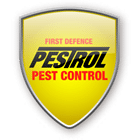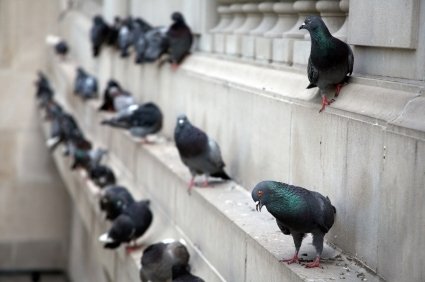
What are the major problems associated with a bird infestation?
What is the life-cycle of birds?
How do you control problem birds?
Other types of bird repellers and deterrents
Birds are harmless (for the most part) and will generally coexist peacefully with their human counterparts; that is until they wander into areas inhabited by humans. In the wild birds are beautiful, majestic creatures that we admire, but once they trespass on your property, they become a nuisance that needs to be dealt with expeditiously.
This is because birds cause more harm than you could figure from just looking at them.
What are the major problems associated with a bird infestation?
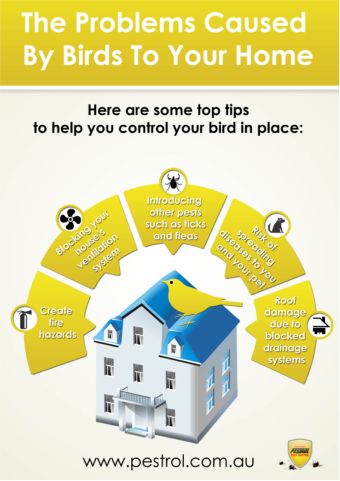
1. Property damage. Birds will damage your property with their:
- Droppings. Bird poop is responsible for the bulk of the damage caused by birds on property. Because their droppings contain high levels of uric acid (a 3 – 3.5 pH substance), they corrode materials such as steel, stone, and paint causing serious damage to the surfaces they come into contact with. The white droppings also damage the aesthetic of structures requiring expensive clean-ups.
- Nests. Usually constructed of straw and grass, nests will sometimes block roof drains and gutters causing damage to the roofs of buildings. They’ll also affect air circulation when built in vents as well as pose a fire hazard when built in electrical components such as control boxes.
2. Noise. Birds make a lot of noise especially when they gather in large numbers, which could be disruptive to work and other activities.
3. Health risks. Bird poop is teeming with disease-causing micro-organisms (mainly fungi and bacteria) which when taken into the human body through inhalation or ingestion could cause serious illness and, in extreme situations, death.
4. Accidents. When wet, bird poop is extremely slippery and could cause accidents resulting in serious injuries. Liability suits could also ensue if a customer is injured at your premises.
5. Contamination and damage to food. Birds will destroy and contaminate food when they get into warehouses, farms and food stores rendering it unfit for human consumption.
Common Pest birds in Australia include the Common Myna, English Starling, House Sparrows, Pigeons, and Sea Gulls.
What is the life cycle of birds?
Shortly after fertilisation, the female bird will search and identify a place to lay her eggs – usually in a nest or hole in the ground, depending on species. A majority of birds, however, do prefer building complex nests in the shapes of mounds, domes or plates to breed and live in.
The fertilised eggs need to be incubated to attain the critical temperature necessary for embryo development. The incubation period lasts until all the eggs hatch.
In monogamous species, the egg incubation responsibilities are shared between both parents while the burden lies with one of the parents in polygamous arrangements. Warmth is passed to the eggs through bare skin patches on the bird’s abdomen and breast called ‘brood patches.’ Depending on the species, eggs take anywhere between 10-80 days to hatch.
Chicks will either be brought up by both or one parent for monogamous and polygamous species respectively.
How do you control problem birds?
The first line of defence against birds is prevention. Birds, like most living creatures, are attracted to food. Ensure that there is no food on your property that could attract these pests. Disposal of your garbage should be done responsibly in secure locations and bins that are covered to deny these and other pest intruder’s access.
Although eliminating food sources is a major deterrent, it does not guarantee a bird free surrounding. If birds are still lingering around your property, other control measures need to be taken.
But since birds are an important part of the ecosystem and in some regions protected by law, only humane measures can be taken to keep them out of your hair. We shall be looking at some of the most effective humane bird control methods namely bird spikes, bird netting, and bird repellers and bird deterrents.
Bird control spikes
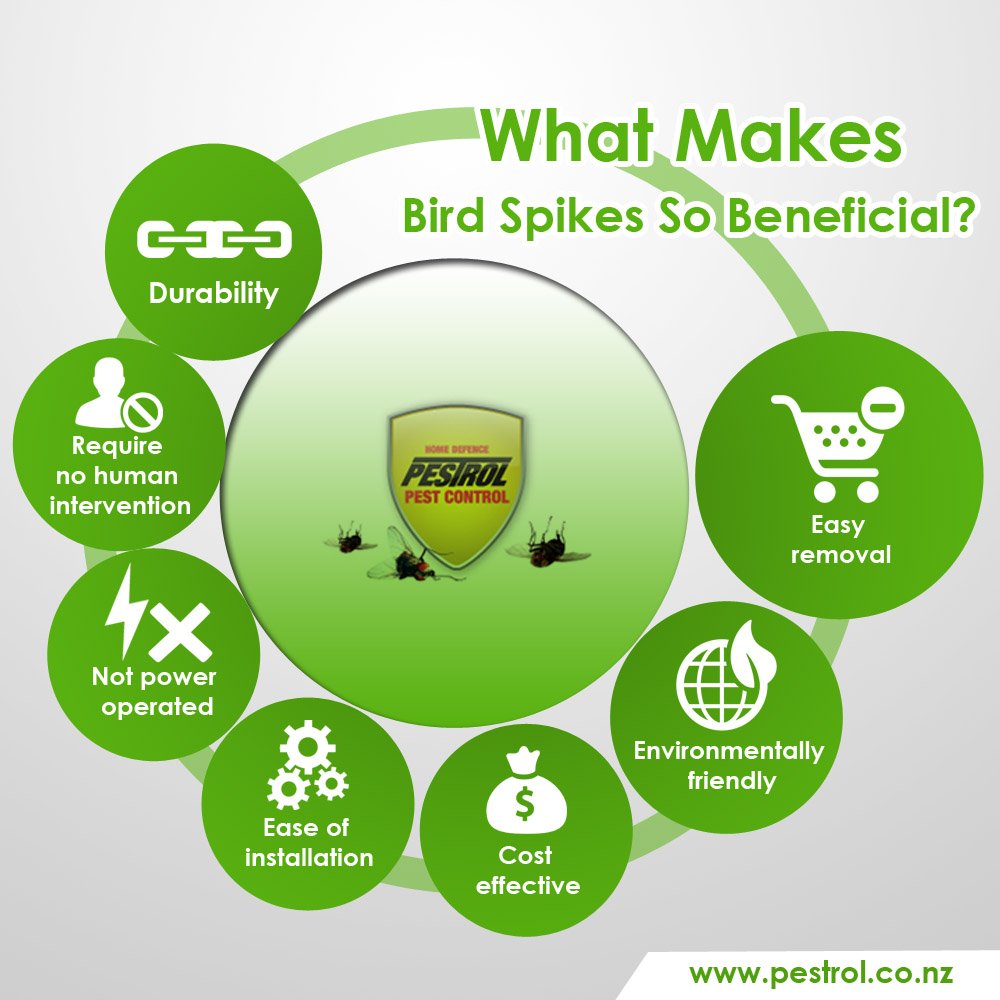
These are also referred to as anti-roosting spikes or simply bird spikes. They are devices that constitute of long projecting rods mounted on a solid base. They can be constructed from either stainless steel, UV-resistant polycarbonates or a combination of both.
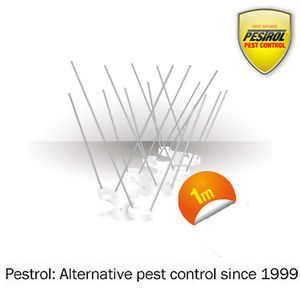 The outward projecting rods (or spikes) make it impossible for birds to perch on structures forcing them to find another place to inhabit. The density and length of the spikes will depend on the type of bird you want to control with smaller birds requiring shorter but closely packed spikes and vice versa for larger birds.
The outward projecting rods (or spikes) make it impossible for birds to perch on structures forcing them to find another place to inhabit. The density and length of the spikes will depend on the type of bird you want to control with smaller birds requiring shorter but closely packed spikes and vice versa for larger birds.
Spikes are ideal for use on pipes, building ledges, roof apex, commercial signage, street lighting among other structures birds could roost on.
Installation
Installing bird spikes is pretty easy and straightforward, ideal for a DIY project. For polycarbonate bird spikes, all you need is a special adhesive to stick them onto the surface you want to protect while fasteners will work fine for steel spikes.
Benefits of using anti-roosting spikes
These include:
1. Discreetness. Bird spikes are good at blending in which makes them difficult to spot from a distance. They will, therefore, not affect the aesthetics of the structure being protected.
2. Easy installation. No special skills are required to install bird spikes so the user can do it themselves.
3. Easy maintenance. Once installed, very little maintenance is required to keep the spikes functional.
4. Humane control. Other than preventing birds from perching, spikes will cause no harm to the birds.
Bird netting
Bird netting resembles any other kind of net in appearance, the main difference being the material they are constructed with as they need to be both strong and weather resistant. They work great for all types of birds and the holes on the net can be designed to keep specific species at bay.
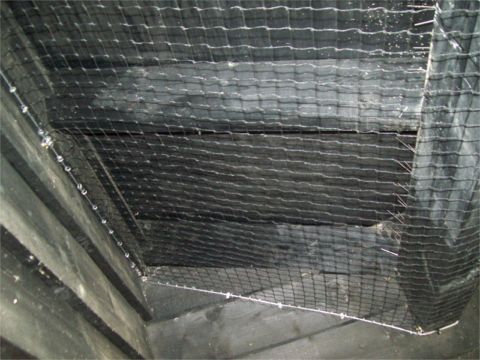
Bird netting works by physically eliminating access for birds to the protected area. They can be used to protect backyards, overhangs, rooftops, backyards and individual plants.
Installation
The method of installing bird netting will depend on aspects such as the environment surrounding the area you want to protect and/or the architecture of the structure. Different skills and equipment will be required for each individual scenario.
For domestic use, user installation is not that technical and will require a few anchoring points for the net to be fastened to. Nets can also be used to protect home gardens by hanging them overhead or resting the net directly on top of the individual plant.
Benefits of using bird netting
These include:
1. Eco-friendliness. Nets neither emit toxins nor affect the environment in any way.
2. Affordability. Bird netting is cheap to buy and install especially when you do it yourself.
3. 100% effectiveness. Bird netting will effectively keep all targeted birds off your property.
4. Discreetness. The net blends in and is difficult to spot from afar.
Other types of bird repellers and deterrents
Other than bird spikes and bird netting, there are other kinds of repellers and deterrent suitable for various situations.
These include:
Sound repellers
These are devices that use sound, either audible or inaudible (ultrasonic sound), to scare birds away from your property. They either work by using a motion detector as a trigger or with set time intervals to produce bird repelling sounds.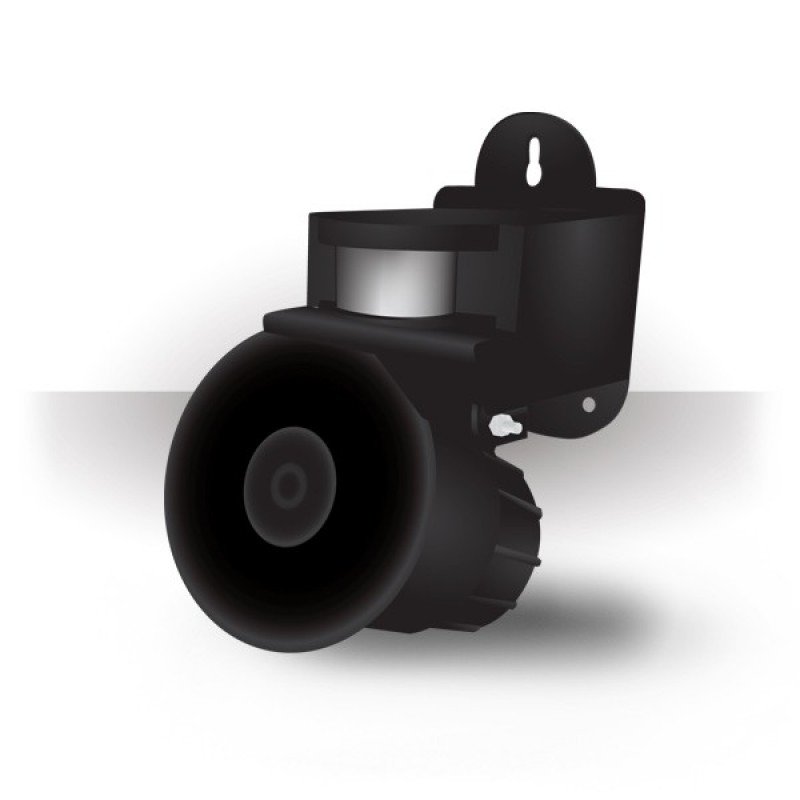
Since they are meant for outdoor use, these types of repellers are built to withstand the elements and generally use a combination of batteries and solar for power.
They are suitable for protecting vast outdoor spaces such as gardens, farms, yards, and orchards. Installation is pretty straight forward for these devices and can be done by the user.
Benefits of sound repellers
These include:
1. Coverage for expansive areas. Sound repellers, especially audible sound repellers are capable of protecting large areas such as farms and orchards.
2. They are easy to install and use. Instructions that come with the devices are quite easy to follow.
3. They provide additional protection from other animal intruders. Sound repellers will work indiscriminately to keep away all animal intruders including feral cats and dogs.
4. 24/7 protection. Their battery power sources ensure they protect your property at all times.
Visual deterrents
These work by exploiting the birds’ vision to scare them away. They can either use reflections such as holographic tapes, strobe lights, or scarers that resemble predatory birds or human beings.
These are ideal for gardens, balconies, farms, private beaches, ponds among other outdoor areas. Installing these only entails placing them in an area or position where intruding birds can see them.
Benefits of visual deterrents
They are:
1. Quiet. Which makes them ideal for places where noise is not desired.
2. Humane. As they cause no harm to the birds.
3. Low maintenance. All you need is to periodically check whether they are still in place.
4. Cheap. Both in acquisition and installation.
Read about our bird deterrents >
Physical repellers
These use a physical medium such as a water jet to scare away birds from your property. Like sound repellers, they are also motion triggered and use a combination of rechargeable batteries and solar for energy.
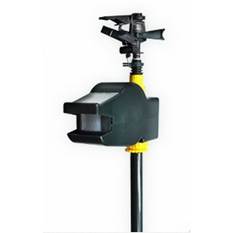
(A water jet repeller)
These are ideal for smaller areas like yards and vegetable patches. Physical bird deterrents are made to be consumer products, so user installation is hassle free.
Benefits of physical repellers
Physical repellers are:
1. Eco-friendly. They emit no harmful substances to the environment and use renewable power for their operation.
2. Safe. Physical bird deterrents (other than scaring birds away) will neither cause harm to the birds nor other animals.
3. Effective. These devices are very effective at keeping birds, and other animals off the protected are.
4. Effective against other intruders. Physical deterrents also work well for other animal intruders such as possums and feral dogs.
As you can see, there are numerous options available for keeping bird pests off your property. The particular one you choose will depend on the area you want to protect and the surrounding environment and circumstances.
View Pestrol’s bird control products > вивус займ личный кабинетзайм спб срочнозайм под материнский капитал иркутск

